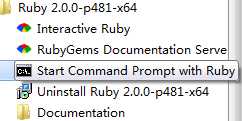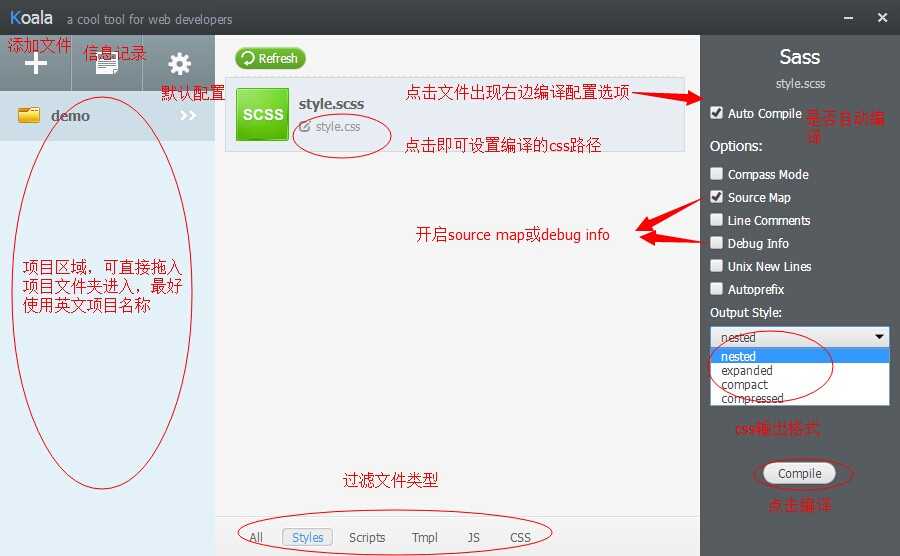标签:
我们都知道,css没有变量,也没有条件语句,在开发过程中,难免有些麻烦,因此有了CSS预处理器(css preprocessor),Sass便是其中之一。
一、什么是Sass
Sass (Syntactically Awesome StyleSheets)是css的一个扩展开发工具,它允许你使用变量、条件语句等,使开发更简单可维护。这里是官方文档。
二、安装是Sass
因为Sass依赖于Ruby环境,所以安装Sass前,需要安装Ruby环境,官网下载。
安装时请勾选Add Ruby executables to your PATH这个选项,添加环境变量,不然以后使用编译软件的时候会提示找不到ruby环境
(安装Ruby时,路径中请勿出现中文,避免后续安装Sass失败)

安装完Ruby环境后,在开始菜单中,找到刚才安装的ruby,打开Start Command Prompt with Ruby

然后直接命令行输入
gem install sass
按回车确认,等待一段时间就会提示Sass安装成功,现在因为墙的比较厉害,如果没有安装成功,请参考淘宝的RubyGems镜像安装sass,如果成功则忽略。
$ gem sources --remove https://rubygems.org/
$ gem sources -a https://ruby.taobao.org/
$ gem sources -l
*** CURRENT SOURCES ***
https://ruby.taobao.org
# 请确保只有 ruby.taobao.org
$ gem install sass
三、编译Sass工具
Sass文件后缀为 .scss,因此要编译成 .css 文件。
1)命令行编译
sass style.scss style.css
Sass 提供4种编译风格
# nested:嵌套缩进的css代码,它是默认值。 # expanded:没有缩进的、扩展的css代码。 # compact:简洁格式的css代码。 # compressed:压缩后的css代码。
生产环境当中,一般选择最后一项。
sass --style compressed style.sass style.css
也可以监听某个文件或目录,一旦文件发生改变,就自动生成编译后文件
# 单文件监听命令
sass --watch input.scss:output.css
# 文件夹监听命令
sass --watch app/sass:public/stylesheets
css文件转成sass/scss文件(在线转换工具,css2sass)
sass-convert style.css style.sass
sass-convert style.css style.scss
2)GUI工具编译
koala , 一个优秀的免费编译器,界面清晰简洁,操作起来也非常简单,详细介绍大家可以移歩到大漠的博客:Less/Sass编译工具,koala使用指南,点击下载 koala 简单操作如下图:

3)编辑器编译
某些编辑器就内置了Sass编译,如webstorm等,而sublime text也有相应的插件可以使用:编译,保存即编译。
4)自动化工具编译,参考我的gulp 学习总结文章。
四、基本语法
1)变量
sass的变量名必须是一个$符号开头,后面紧跟变量名
//sass 样式 $red: #f00; div { color: $red; } // 编译为css后 div { color:#f00; }
特殊变量:如果变量嵌套在字符串中,则需要写在 #{} 符号里面,如:
$top: top; div { margin-#{$top}: 10px; /* margin-top: 10px; */ }
默认变量:仅需在值后面加入 !default即可, 默认变量一般用来设置默认值,当该变量出现另外一个值时,无论定义先后,都会使用另外一个值,覆盖默认值
$color: red; $color: blue !default; div { color: $color; /* color:red; */ }
多值变量:多值变量分为list类型和map类型,list有点像js对象中的数组,map类型像js中的对象
list : 可通过空格,逗号或小括号分割多个值,使用 nth($变量名, $索引)取值。 list数据操作有其他函数,具体参考sass Functions
//一维数据 $px: 5px 10px 20px 30px; //二维数据,相当于js中的二维数组 $px: 5px 10px, 20px 30px; $px: (5px 10px) (20px 30px); // 例子 $px: 10px 20px; div { margin:nth($px, 1) 0 0 nth($px, 2); /* margin:10px 0 0 20px; */ }
map: 数据以key和value组成,格式:$map: (key1: value1, key2: value2); 通过map-get($map, $key);
$headings: (h1: 2em, h2: 1.5em, h3: 1.2em); @each $header, $size in $headings { #{$header} { font-size: $size; } }
2)计算功能
sass允许使用算式。
div { padding: 2px * 4px; margin: (10px / 2); font-size: 12px + 4px; }
3)嵌套
标签嵌套
// sass 样式 div { color: #333; a { font-size:14px; &:hover { text-decoration:underline; } } } // 编译后css div { color: #333; } div a { font-size:14px; } div a:hover { text-decoration:underline; }
属性嵌套:
//sass 样式 .fakeshadow { border: { style: solid; left: { width: 4px; color: #888; } right: { width: 2px; color: #ccc; } } } //css 编译后样式 .fakeshadow { border-style: solid; border-left-width: 4px; border-left-color: #888; border-right-width: 2px; border-right-color: #ccc; }
4)注释
sass有两种注释风格
标准css注释: /* 注释 */, 会保留到编译后的文件中,压缩则删除
单行注释: // 注释
在标准注释 /*后面加入一个感叹号,表示重要注释,压缩模式也会保留注释,用于版权声明等。
/*! 重要注释 */
5)继承
sass 中,选择器继承可以让选择器继承另一个选择器的所有样式
// sass样式 h1 { font-size:20px; } div { @extend h1; color:red; } // css编译后样式 h1 { font-size:20px; } div { font-size:20px; color:red; }
使用占位符选择器 %
从sass3.2.0后,就可以定义占位选择器%,这个的优势在于,不调用不会有多余的css文件
// sass样式 %h1 { font-size:20px; } div { @extend %h1; color:red; } // css编译后样式 div { font-size:20px; color:red; }
6)混合(mixin)
sass中使用@mixin声明混合,可以传递参数,参数名义$符号开始,多个参数以逗号分开,如果参数有多组值,那么在变量后面加三个点表示,如: $var...
//sass 样式 @mixin opacity($opacity:50) { opacity: $opacity / 100; filter: alpha(opacity=$opacity); } .opacity{ @include opacity; //参数使用默认值 50/100 = 0.5 } .opacity-80{ @include opacity(80); //传递参数 80/100 = 0.8 } // css编译后样式 .opacity{ opacity: 0.5; filter: alpha(opacity=50); } // --------------------- // 多参数 @mixin center($width, $height) { position: absolute; left:50%; top:50%; width:$width; height:$height; margin:(-$height / 2) 0 0 (-$width / 2); } div { @include center(200px, 100px); } // css编译后样式 div { position: absolute; left:50%; top:50%; width:200px; height:100px; margin:-50px 0 0 -100px; } // ------------------- //多组值 @mixin box-shadow($shadow...) { -webkit-box-shadow: $shadow; box-shadow: $shadow; } div { @include box-shadow(0 1px 0 rgba(0,0,0,.4), 0 -1px 1px rgba(0,0,0,.4)); } // css编译后样式 div { -webkit-box-shadow: 0 1px 0 rgba(0,0,0,.4), 0 -1px 1px rgba(0,0,0,.4); box-shadow: 0 1px 0 rgba(0,0,0,.4), 0 -1px 1px rgba(0,0,0,.4);
}
@content:在sass3.2.0中引入, 可以用来解决css3中 @meidia 或者 @keyframes 带来的问题。它可以使@mixin接受一整块样式,接收的样式从@content开始
//sass 样式 @mixin max-screen($res){ @media only screen and ( max-width: $res ) { @content; } } @include max-screen(480px) { body { color: red } } //css 编译后样式 @media only screen and (max-width: 480px) { body { color: red } }
使用@content解决@keyframes关键帧的浏览器前缀问题
// 初始化变量 $browser: null; // 设置关键帧 @mixin keyframes($name) { @-webkit-keyframes #{$name} { $browser: ‘-webkit-‘; @content; } @-moz-keyframes #{$name} { $browser: ‘-moz-‘; @content; } @-o-keyframes #{$name} { $browser: ‘-o-‘; @content; } @keyframes #{$name} { $browser: ‘‘; @content; } } // 引入 @include keyframes(scale) { 100% { #{$browser}transform: scale(0.8); } } // css编译后 @-webkit-keyframes scale { -webkit-transform: scale(0.8); } @-moz-keyframes scale { -moz-transform: scale(0.8); } @-o-keyframes scale { -o-transform: scale(0.8); } @keyframes scale { transform: scale(0.8); }
7)颜色函数
sass提供了一些内置的颜色函数
lighten(#cc3, 10%) // #d6d65c
darken(#cc3, 10%) // #a3a329
grayscale(#cc3) // #808080
complement(#cc3) // #33c
8)引入外部文件
使用 @import 命令引入外部文件, 引入后,可使用外部文件中的变量等。
@import "_base.scss";
五、高级用法
1)函数 function
sass允许用户编写自己的函数,以@function开始
$fontSize: 10px; @function pxTorem($px) { @return $px / $fontSize * 1rem; } div { font-size: pxTorem(16px); } // css编译后样式 div { font-size: 1.6rem; }
2)if条件语句
@if语句可以用来判断
// sass样式 $type: monster; div { @if $type == ocean { color: blue; } @else if $type == matador { color: red; } @else if $type == monster { color: green; } @else { color: black; } } // css编译后样式 div { color: green; }
三目判断:语法为 if($condition, $if_true, $if_false)。 三个参数分别表示: 条件,条件为真的值,条件为假的值
if(true, 1px, 2px) => 1px
if(false, 1px, 2px) => 2px
3)循环语句
for循环有两种形式,分别为:@for $var from <start> through <end> 和 @for $var from <start> to <end>。 $var 表示变量,start表示开始值,end表示结束值,两种形式的区别在于 through 包括 end 的值,to 不包括 end 值。
// sass样式 @for $i from 1 to 4 { .item-#{$i} {width: 2em * $i;} } // css编译后样式 .item-1 { width: 2em; } .item-2 { width: 4em; } .item-3 { width: 6em; }
while循环
// sass样式 $i: 2; @while $i > 0 { .item-#{$i} {width: 2em * $i;} $i: $i - 1; } // css编译后样式 .item-2 { width: 4em; } .item-1 { width: 2em; }
@each循环:语法为@each $var in <list or map>。 其中$var表示变量,而list和map表示数据类型,sass3.3.0新加入多字段循环和map数据循环
单字段list数据循环
//sass 样式 $animal-list: puma, sea-slug, egret; @each $animal in $animal-list { .#{$animal}-icon { background-image: url(‘/images/#{$animal}.png‘); } } //css 编译后样式 .puma-icon { background-image: url(‘/images/puma.png‘); } .sea-slug-icon { background-image: url(‘/images/sea-slug.png‘); } .egret-icon { background-image: url(‘/images/egret.png‘); }
多字段list数据循环
//sass 样式 $animal-data: (puma, black, default),(sea-slug, blue, pointer); @each $animal, $color, $cursor in $animal-data { .#{$animal}-icon { background-image: url(‘/images/#{$animal}.png‘); border: 2px solid $color; cursor: $cursor; } } //css 编译后样式 .puma-icon { background-image: url(‘/images/puma.png‘); border: 2px solid black; cursor: default; } .sea-slug-icon { background-image: url(‘/images/sea-slug.png‘); border: 2px solid blue; cursor: pointer; }
多字段map数据循环
//sass 样式 $headings: (h1: 2em, h2: 1.5em, h3: 1.2em); @each $header, $size in $headings { #{$header} { font-size: $size; } } //css 编译后样式 h1 { font-size: 2em; } h2 { font-size: 1.5em; } h3 { font-size: 1.2em; }
六、在线工具
参考资料:
阮一锋: Sass用法指南
标签:
原文地址:http://www.cnblogs.com/morong/p/4329957.html